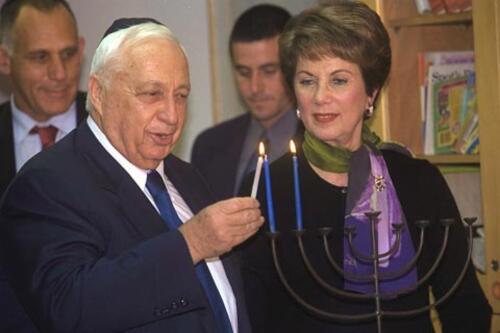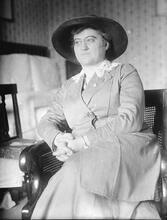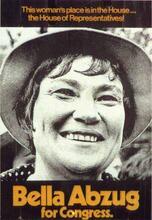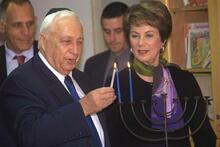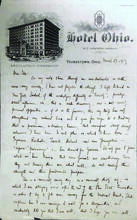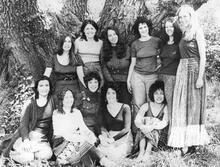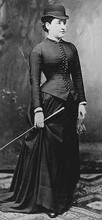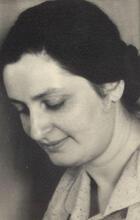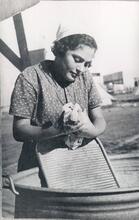Non Governmental Organizations (NGOs) in Israel, 1948-2000
Courtesy of a private collection.
The earliest women’s NGOs in Israel played a socializing role, helping to build the nation by preparing women for a female workforce and domestic care. Over the years, their structure, behavior, values, and outcomes have been modified. Women’s NGOs expanding and proliferated, mobilizing women from all social segments. They modified their strategies, shifting from nurturing and providing welfare services to confronting the authors and acting to enhance women’s equality. They have brought new feminist issues relating to women’s bodies and women’s roles in the feminist arena. Women’s NGOs have been highly successful in mobilizing support, inculcating feminist ideas into public discourse, and initiating legislation. Yet ideological, social, economic, and political constraints continue to hamper women’s equality.
On International Women’s Day 2019 (March 7), the front page of a magazine published by the newspaper Ha'aretz heralded that women had "Shattered all glass ceilings." While this assertion may be overly optimistic, women have made important strides in Israeli society. Women's non-governmental organizations (NGOs) have been key to this progress, and their history also reveals the hurdles that continue to block women’s full equality.
Throughout Israel’s history, women’s organizations have vacillated between carrying the national flag and the feminist banner (Yishai 1997), between their commitment to the process of nation building and their pledge to enhance women’s share of the political and economic resources available to Israeli citizens. These two goals often appeared incompatible. During the formative period of the state, women’s organizations showed preference for the national track. Since the 1980s, however, more emphasis has been placed on gender equality, with more consideration given to the interests of women per se. This trend has accelerated during the 2000s.
Concomitant changes have occurred in the structure, strategies, agenda, and impact of women's NGOs. They have expanded and proliferated and adopted new strategies that expose the gendered dimensions of society, ensuring that women's interests are not overlooked by the political authorities. Today, the agendas of women's NGOs are no longer restricted to women's welfare but encompass a wide variety of feminist concerns. However, their impact, while noticeable, is only partial, not surprising in view of the constraints under which the feminist cause in Israel operates.
The Context: Constraints on Women's Equality
Women’s organizations in Israel operate under four major constraints: religious, social, economic, and political.
Cultural-religious norms, rooted in the ancient Jewish heritage, hamper women’s equality. Traditional Judaism clearly relegates women to caring and domestic functions, treating them not as equal to men, but at best as different. According to this tradition, a woman’s honor is in her home and she is expected to cater to the needs of her family. It is a fundamental Jewish tenet to multiply and bear children, and it is the mother’s exclusive responsibility to take care of the children. In modern times the influence of religion has had both legal and social consequences. Religious authorities have a monopoly on critical personal status laws (marriage and divorce), putting women at a disadvantage. Religion’s significance in Israeli society emanates not only from political expediency but also from deeply rooted values, as the Jewish character of the state of Israel has been contested only at the margins. Women’s NGOs have therefore had to operate in a society whose fundamental values assigned women primarily a domestic role.
Second, society in Israel revolves around the Israeli-Palestinian conflict. The basic conception of woman’s role as “mother” did not accord well with her role in the military, a prominent institution in Israeli society. Although women are conscripted into the army (albeit for a shorter term than men) and currently serve in combat units, their involvement in the armed forces is subject to debate. Because high-ranking military service provides an effective ticket for political and economic positions, the paucity of women in the top echelons of army ranks denies them an important avenue of political mobility.
Thirdly, neo-liberal policy, complemented by public budget contractions, left women to cope with their own economic plight. While women joined the labor force en masse following the establishment of the state (with the percentage of working women rising from 26.5% in 1955 to 68.6% in 2018), income differentials persisted, with women’s earnings approximately one-third those of men. Likewise, occupational distribution remains uneven, with women concentrated in low-paying jobs (Fuchs 2017), and women's share in the higher strata of economic management is miniscule. With many women underpaid and lacking economic security, their mobilization to civil action may be hindered.
Finally, although women in Israel have gained political power over time, they are still underrepresented in all major high-ranking political institutions. In the 20th Knesset (2015-19), a record 36 out of 120 seats were held by women, but only 29 women were elected to the 21st Knesset in 2019. As of December 2016, Israel ranked 20th out of 35 OECD countries in terms of female representation in parliament. Women are also under-represented in the cabinet and in the leadership of major political parties.
The following sections will show how, over the past decades, women have attempted to cope with these constraints by expanding, adopting new strategies, espousing a new agenda, and consequently increasing their influence on the public sphere.
Expansion & Proliferation
Since 2000 women's organizations have undergone significant expansion and proliferation. Prior to 1980 only fourteen women's NGOs existed, but by 2018 more than two hundred were identified (Heruti-Sover 2018), with many more unregistered. This remarkable development occurred in three consecutive stages (Abramovich 2008). First, from Israel’s independence in 1948 to 1969, the foundations for structured women's action were laid. The second stage, from 1970 to1990s, was characterized by the rise of feminist ideology. The third period, from 2000 onwards, has been characterized by specialization and grassroots mobilization.
Women's associational scene in the first stage was dominated primarily by two organizations, Mo'etzet Ha'poalot (Council of Women), and WIZO (Women’s International Zionist Organization), both linked, to varying extents, to the political establishment. Mo’ezet Ha'poalot was established in 1920 as the female branch of the Histadrut (Labor Federation). Its activities were carried out mainly by an adjunct association, the Organization of Work-at-Home Mothers. "Mothers" were called upon to cultivate in their homes the atmosphere and cultural milieu deemed appropriate for the fledgling working class dominated by men. As an appendage to the establishment, women members were dependent on men’s political and economic resources. Although Mo'etzet Ha'poalot, later known as Na'amat, secured a wide membership, the extensive mobilization was not grounded in feminist consciousness but rather in the Histadrut ruling (valid until 1994) making membership in the Histadrut a necessary condition for gaining access to public health services. In fact, Mo'etzet Ha'poalot, at that time, was far from feminist. It concentrated on offering women occupational education, often in "pink" vocations, such as cosmetics and hair design. Its main function was to aid women working outside their homes by providing them with day-care facilities. The organization shared the imperative of stabilizing fragile state institutions coping with mass immigration and security imperatives.
WIZO, the second largest women’s organization (also established in 1920), aimed at improving life for women and children in the land of Israel. While officially non-political, WIZO was indirectly linked to the General Zionists, the economic-liberal party of Israel. But it was primarily a mainstream charity attracting upper-middle-class women whose main interest was the welfare of the needy, particularly new immigrants. The national theme was unequivocally emphasized: “WIZO set itself the task of turning these human wrecks into good, useful citizens of the country” (quoted in Yishai 1997).To accomplish this goal, WIZO established baby clinics, day-care institutions, training courses in sewing and homemaking, playgrounds for poor children, agricultural schools, and youth centers. This partial list demonstrates WIZO’s traditional orientation: preparing women to take an active role in the process of nation building by improving their domestic skills. In the conflict between the national flag and the feminist banner, the flag took a leading role.
While attempting to improve the status of women and help them integrate into the labor market, then, the early women’s NGOs’s agendas were by and large not feminist. Occasionally, their leaders were gatekeepers of the transition from the female enclave to the political establishment dominated by men, but in doing so they served as "fig-leaves" for a system that was essentially closed to women's claims (Herzog 2004).
The second stage, from 1970 through the 1990s, was characterized by two major developments. First, Israel witnessed the emergence and institutionalization of organized feminism. Second, women's NGOs sought a new terrain: lobbying the political authorities. For this purpose, another major organization joined the women's associational scene, the Israel Women’s Network (IWN).
Feminism was comparatively late to arrive in Israel. Israelis were preoccupied with the perpetual Arab-Israeli conflict, with creating a strong economy, and with the material pursuit of the good life. Self-fulfillment and civil rights were not high on the list of priorities. Students did not challenge the institutional order by holding street demonstrations, consumers did not organize to safeguard their rights, and women on the whole remained passive, accommodating themselves to their traditional roles and inferior social status. But during the 1970s, following the Six-Day War, Israelis, women included, became more exposed to winds blowing from the Western world.
The inception of the Feminist Movement (FM) occurred in Haifa in 1972 when Marcia Freedman founded a branch of the Women’s Liberation Movement (Freedman 1990). Separate sister organizations sprang up soon after in Tel Aviv and Jerusalem. During the years that followed, feminist activity took off. Feminist centers, shelters for battered women, and rape crisis centers were established in the big cities; feminist movements were involved in educational and awareness-raising activities; centers for women’s studies were established at major universities; and feminist publications were issued regularly. Israeli feminism, however, differed from that emerging in other countries, particularly the United States, because the "Flag" continued to hover high. Excitement with the outcome of the Six-Day War affected men and women alike. National sentiments engulfed the country, overshadowing sectional interests. Feminism was still embryonic, on the margins of politics and society.
In 1984 women's NGOs took a different course by launching a lobbying arm. The Israel Women’s Network was established in Jerusalem by women academics and professionals, headed by Prof. Alice Shalvi. Unlike its predecessors (Mo'etzet Ha'poalot and WIZO), the IWN concentrated on the legal aspects of women’s equality, rather than providing welfare services. Although the Israeli legal code included several laws promoting and safeguarding women’s rights, most of these remained on paper only. Marked gender disparities continued to exist in society, the economy, and the polity; there was no law regarding domestic violence or equality in the workplace, and women’s representation in the Lit. "assembly." The 120-member parliament of the State of Israel.Knesset was at a record low.
The IWN espoused a legal and political agenda. It gave precedence to legislative and advocacy activity over the provision of welfare services, postulating that women’s equality was to be gained by political means in the corridors of power, not by playing an auxiliary role to the state’s welfare and educational agencies. In contrast to the veteran women’s organizations, the IWN did not establish day-care institutions or provide vocational training for women. In contrast to Mo'etzet Ha'poalot and WIZO, which were overtly or covertly linked to political parties, the IWN was both multi-partisan and nonpartisan. It served as a forum for women of all political parties or none, providing a coherent, coordinated framework for the female voice in Israeli politics and society.
In the third stage, from 2000 to date, women's NGOs expanded, mushroomed, and became more specialized. Although no accurate data exist regarding the number of women's NGOs, requests for grants to finance feminist activity in 2018 testify to more than 200 (Heruti-Sover 2018), a figure that does not include many associations that did not apply for funding. The women's NGOs exhibit a wide regional, ethnic, and social variety. Some, such as Centers for Combatting Violence against Women, cater to the needs of women across the country, disregarding ethnic, social, national, and age differences. Others address more specific issues. Granit, for example, focuses on aid to women in the process of divorce, and Yachdav represents Ethiopian women, subject to discrimination and prejudice. Likewise, no accurate data exist on the number of women involved in women's NGOs, but the dramatic organizational expansion attests to a widening mobilization. Admittedly, some associations (such as Klaf, a lesbian association) do not survive financial hardships, but at the same time many new associations join the feminist landscape.
This third stage of feminism, in contrast to the former two, is also characterized by a dramatic growth in NGOs specializing in women's particular needs: combating specific type of violence, economic equality in particular industries, family affairs, professional interests, cultural and identity aspects, communication, sports, and politics. Sprouting NGOs both reflect and shape women’s concerns on the basis of particular grievances, demands, and aspirations.
Issue proliferation was concomitant to the organizational expansion. An illuminating case is violence against women. The first shelter for battered women was established in 1982; by 2018 there were fourteen such shelters throughout the country. The effort to eliminate aggression and cruelty has attracted widespread public attention, leading to the formation of many associations addressing prostitution and trafficking in women (more than ten NGOs), pornography, rape, injurious advertising, desertion (agunot), and more (Fogel Bijaoui 1992). Proliferation was evident in almost all walks of women's life. There are about sixteen organizations focusing on the plight of Palestinian women that embody new forms of activism and historical tensions between gendered and national struggles; when these women promote their national rights, their gender roles are dismissed, and when the advocate for gender equality, the national theme is minimized (Marteu 2009). Home birth, a practice involving only a few hundred women, is promoted by no less than three NGOs, all suffering from weak organizational configuration. Both expansion and proliferation made women's voices more diverse, distinct, and manifest.
Female civil society has increasingly been shaped by grassroots activity, some of which is short-lived. Grassroots associations provided women with supportive settings and emotional backing to mitigate hostility to feminism and cater to personal grievances. But without an organizational structure, effectiveness was often low. Hence institutionalization ensued: the NGOization of the female civic arena (Herzog 2008). Women's NGOs fulfilled the requirement of registering with the Associations' Registrar and adhered to strict rules, such as holding internal elections and auditing. Institutionalization provided women’s NGOs with the opportunity to solicit contributions and to act as lobbyists for policy change. Formal NGOs have been more capable than grassroots associations of effectively influencing the political agenda by gendering social discourse and practice.
Strategies
As the female civic arena became more diverse and transient, shifts in strategies ensued. The strategies of women's NGOs during the 2000s were characterized by two trends: confrontation with the political authorities and collaboration within the NGO arena.
As noted above, in the formative years women's NGOs concentrated on the fulfillment of national goals. They may have sheltered women from the vicious world outside their domestic environment but they also confined them to a female enclave. In the contemporary era, by contrast, women's NGOs presented clear and pressing demands to the political authorities. Although they shied away from protest actions and did not strike or hold sit-ins in state offices, they raised their voices in a quest for decisive action. For this purpose, they adopted two strategies: mobilization and training for political positions.
In the past, membership in a women's NGO had either been automatic, based on joining the Histadrut, or a social activity typical of the upper-middle-class. In the 2000s there was no longer a pool of women readily available for mobilization, both because the Histadrut had lost much of its appeal and the link between Histadrut membership and health care was severed by the introeduction of a National Health Insurance law. Although feminism as a concept has become more accepted, mobilization to the feminist cause was necessary in order to involve women in NGO activity. The media and social forums have actively solicited women's support, and women of all walks of life have become aware of their rights. Some were also willing to engage in civic action. Women's NGOs also trained women for political life, especially but not solely by the veteran organizations. Training efforts increased particularly during electoral campaigns, during which a support system was set up to encourage women to present their candidacies for political positions, and financial and organizational resources were solicited to help women get elected. For example, the IWN increased its financial investment in courses aimed at preparing women for political life from 60.9 percent of its activity budget in 2009 to 72 percent in 2017 (Guidestar 2009; 2017).
Women's NGO also became more collaborative. Because of their high numbers, women’s organizations could have been prone to rivalry and contention, but by and large this has not been the case. One notable example of cooperation is Shutafot (Partners), a coalition of women acting to eliminate gender discrimination in the workplace. Another is the Coalition for Peace, in which Arab and Jewish women collaborate to promote Israeli-Palestinian conciliation. This coalition includes, among others, Bat Shalom, Women in Black, Mothers and Women for Peace, and Women for Coexistence. Although these NGOs vary in economic, ethnic and national characteristics, they nevertheless conjoin both ideologically and organizationally. The need to coalesce was deliberately stated in a document issued by the IWN noting that its leaders "have recognized the need to reevaluate the role of the organization in the larger scene of Women's Rights organization in Israel." The IWN pledged to work in continuous collaboration with grassroots organizations in order "to maximize the social impact of the forces promoting women's equality and prosperity" (Israel Women's Network 2016).
One strategy is conspicuously missing: unlike women's associations in other Western societies, Israeli feminists did not take to the streets. One glaring exception is a huge demonstration that took place in many locations throughout the county in December 2018, protesting the repeated murder of women (Lanzkron and Staff 2018).
Agenda
A major, albeit gradual, change has also taken place in the platforms of women's NGOs. The most obvious change was the introduction of feminism, Israeli style. Change was gradual and intermittent, but by the 2000s women’s NGOs’ self-identification was unmistakably feminist. When the leader of Na'amat, the guardian of women's domestic roles, stated that her organization "identifies itself as the largest feminist organization in Israel," this was not a hollow statement but sincerely echoed the changing ambiance (Carmon 2016).
Women’s NGOs have challenged the dominant cultural code and created new gender canons. The change of ideological course was evident in the shift of attention from vulnerable women—mothers of young children, those deprived of a decent income, those in need of learning Hebrew—to women of all walks of life. The main cry was for justice, not compassion. Impartiality was sought in Rabbinical courts that discriminated against women and in police headquarters that were not doing their utmost to prevent violence and homicide. The justice-oriented agenda also targeted women themselves. For example, the organization Achoti (My Sister) challenged the alleged hegemony of Ashkenazi populations, associating feminism with economic affluence.
A noteworthy innovation on the women's NGOs agenda in the 2000s was a new focus on the female body, with all its ramifications. Organized feminism took upon itself to protect women demeaned by commercial use of their bodies. Activity on behalf of prostitutes gained unprecedented momentum, as did the right of women to wear clothing deemed offensive by Orthodox groups. Missing from the agenda relating to the female body, however, was the matter of "free choice" allowing women to terminate pregnancy at their own wish. Abortion, an issue widely dealt with in other Western states, particularly in the United States, has not been part of the agenda of Israeli women’s NGOs. Abortion in Israel requires approval by a statutory committee based on conditions specified by law, thus removing termination of pregnancy from the feminist agenda for reasons that merit further study.
The addition of new issues to women's NGOs’ agendas was complemented by the realization that political engagement is the most (perhaps the only) powerful means to attaining goals. Put differently, women's NGOs have undergone a process of agenda politicization, with two repercussions. First, women's NGOs no longer confine themselves to feminist issues but have become involved in general policy domains. A striking example is the Arab-Israeli conflict, around which a coalition of women's NGOs mobilized. The quest for political representation has also gained priority. With the absence of a women's party, and with no established political party espousing gender equality as a major policy objective, women's associations filled the vacuum by both demanding a higher presence in authoritative institutions and acting to further this cause.
Impact
Impact can be evaluated on the basis of four indicators: (a) mobilization, regarding the volume of feminist activity inspired by women's NGOs; (b) women's benefits, including both material and political gains; (c) public support for the feminist cause, and(d) placement of gender equality on the legislative and administrative agenda. Admittedly, no direct causal connection between women's NGOs and these attainments can be substantiated. However, by their own testimony, and by press accounts, they do have a primary role in advancing women's causes in the economy, in society, and in the polity.
While no reliable data exist, the sheer number of those promoting the feminist cause and the proliferation of associations reveal mounting mobilization, which now encompasses women of all social classes and sectors. Among many other examples, Haredi (extreme religious) women call for representation in the male Haredi political parties, women of the periphery associate to advance equality, old women protest their alleged transparency, and affluent women engage in collective action to safeguard the well-being of women asylum seekers.
Regarding material and political benefits, the picture is mixed. Women have increased their power in political decision-making bodies, but the trend is not linear. More women serve as mayors and members of local councils, but fewer women were elected to the 21th Knesset (2019) than to the previous one (2015). The political authorities apply a gender lens to policy issues and generally support the feminist agenda, but a strong political will to erase gender inequality is lacking (Strichman 2018). Economic gains are also equivocal. Not only does the gender income gap persist, but women's NGOs themselves face financial constraints and a problematic funding landscape. A press report exposed a huge deficit in Na'amat's budget (Heruti-Sover 2019). WIZO and IWN’s financial reports also reveal budget shrinkage.
Feminist consciousness has undeniably been on the rise.The concept of feminism is currently interpreted as less threatening both in society and within authoritative institutions. While the term "feminist" may still be alien to Israel's political culture, the aspirations of feminism are widely endorsed. In an annual survey conducted by Na'amat to celebrate Women's International Day, respondents communicated impressive support for the feminist cause: no less than 88 percent of those polled (both men and women) maintained that a woman can serve as a prime minister, and an even higher percentage (92%) believed a woman is entitled to lead a municipality (On-Life Editorial 2018). It can be cautiously assumed that this support for women serving in the highest echelons of government indicates an expansion of the feminist idea. While there is no proof that women's NGOs are responsible for this shift, they certainly played a leading role in inculcating the idea of women’s equality.
Last, but certainly not least in importance, is the impact on the broader political and administrative agenda. While problems of security still loom large on the national agenda, a change of mood is manifest. Gendered legislation was in many cases inspired by women's NGOs. Data comparing the 12th Knesset (1988-1992) to the 14th Knesset (1996-1999) reveal a significant rise in women-related legislation. In the first period seven laws were enacted. In the second period, the number rose to 51 proposals, 14 of which matured into law (Herman and Golan 2014). In December 2018 women celebrated the approval of a law intended to eliminate prostitution by criminalizing the use of prostitutes, for which women's NGOs took credit. Yet, the perpetuation of gender inequality testifies to the liabilities these organizations face: the income gaps, the financial burdens of infant and child care, and underrepresentation in politics, to name just a few.
Conclusions
The story of women’s NGOs in Israel is the story of state-building. Initially, women’s organizations, while subservient to male-dominated institutions, played an important role in national endeavors. As the state matured, and its borders opened both physically and mentally, feminism surfaced, at first modestly and then gaining momentum. Though the initial implant of the feminist movement was unsuccessful, feminism has prospered owing to four changes in the NGO scene: structural, behavioral, ideological, and political.
First, women's NGOs have expanded from about a dozen in the formative years of the state to a few hundred, manifesting a variety of organizational forms, catering to the needs of a wide assortment of women, and mobilizing diverse social sectors. These include highly structured organizations such as Na'amat, WIZO, and the IWN, as well as grassroots associations, operating intermittently, conjoining to promote a specific case. Women from all walks of life joined the women's NGO community.
Second, a visible change occurred in women's NGOs’ strategies, from cultivation to confrontation. While Na'mmat and WIZO continue to provide child care services, they, along with other organizations, also act to augment women's power. Their mode of action is no longer in the service of the nation, subservient to male-dominated society, but rather targeted at women's specific needs. In order to advance their cause, women's NGOs of a wide range of identities, perceptions, and strategies, joined together for the purpose of fighting shared battles, overriding their differences and disputes over prestige and power.
The third change was ideological. Following shifts in structure and activities, women's NGOs raised new issues on the political agenda. In the formative era, issues pertaining to "ordinary" women, particularly but not only the vulnerable, were of high priority. In the 2000s, the agenda was shaped by an increasingly diverse population. For some women, grievance was manifest in all varieties of physical abuse; for others, the absence of peace was a source of concern, or meager prospects for career advancement. All these wrongs found voice in the platforms of women's NGOs. Confrontation with the authorities was not only a means for advocacy but also part and parcel of the organizational agenda.
Women's NGOs have undergone a process of politicization. To what extent has this course been productive in terms of gender equality? The answer is equivocal. On the one hand are noticeable achievements. Women are currently much better off than they were in the state’s formative era. Yet a great deal remains to be done. The constraints, which are perhaps unique to Israel, include religious influence, security imperatives, the structure of the economy steering women to part-time or "female" jobs, and the paucity of women in powerful economic and political institutions. Domestic violence is still rampant, and the #MeToo movement exposed widespread sexual harassment among the higher echelons of society. The share of women at the apex of the political and the economic institutions is still disproportionately small, if not miniscule, and marginalized women's voices are weak, even within the feminist scene. Moreover, many women are not yet aware of their plight and are not involved in feminist organizations. The current expansion of religious fundamentalism adds fire to the flames of gender inequality. Nevertheless, while women's NGOs do not provide a magic pill to solve all problems emanating from deeply engrained gender inequality in Israel, the headway they have made during the past two decades portends a brighter future.
Abdo, N. Women in Israel: Race, Gender and Citizenship. London: Zed Books, 2011.
Abramovitch, D. Jewish and Jewish-Palestinian Feminist Organizations in Israel. Characteristics and Trends. Tel Aviv: Heinrich Boell Stiftung, 2008.
Azmon, Y. “Women in Israeli Politics.” State, Society and International Relations 33 (1990): 5–19 (Hebrew).
Baker, A. The Jewish Woman in Contemporary Society: Transitions and Traditions. New York: New York University Press, 1993.
Bernstein, D. S. "Human Being or Housewife: The Status of Women in the Jewish Working-Class Family in Palestine of the 1920s and 1930s.” In Pioneers and Homemakers: Jewish Women in Pre-State Israel, edited by D.B. Bernstein. Albany, New York: State University of New York Press, 1992.
Carmon, T. "Breaking the Glass Ceiling. Interview with Na'amat Leader Galia Wolloch." Davar Rishon. October 20, 2016.. https://www.davar1.co.il/37728/
Fogel-Bijaoui, S. “Women’s Organizations in Israel.” International Problems. State and Society 3, 1992: 65–76 (Hebrew).
Freedman, M. Exile in the Promised Land. Ithaca, N.Y. Firebrand Books, 1990.
Fuchs H. Division of Labor: Wage Gaps between Women and Men in Israel. Jerusalem: Taub Center, 2017.
Guidestar (2007; 2017). (https://www.guidestar.org.il/organization/580085686).
Halperin Kadari, R. Women in Israel. A State of their Own. Phil. University of Pennsylvania Press, 2014.
Herman T. and G. Golan. "Parliamentary Representation of women. The Israeli Case." In Parliamentary Representation of Women: A Comparative International Study, edited by M. Tremblay, 251-276. Montreal: Remue-Menage Press, .
Heruti-Sover, T. "Dozens of Israeli Women's Organizations won a $1 Million grant." The Marker, September 4, 2018.
https://www.themarker.com/career/1.6450162
Heruti- Sover. "The deficit skyrocketed and so is the senior's wage." The Marker, March 24, 2019. https://www.themarker.com/career/.premium-1.7045822
Herzog, H. Gendering Politics. Women in Israel. Michigan: University of Michigan Press, 1999.
Herzog, H. (2004). "Women in Israeli Society." In Jews in Israel. Contemporary Social and Cultural Patterns, edited by U. Rebrun and C.I. Waxman. Hanover: Brandeis University Press, 2004.
Herzog, H. "Re/visioning the Women's Movement in Israel." Citizenship Studies 12 (3), 2008: 113-128.
Herzog, H. "NGOization of the Israeli Feminist Movement. Depoliticizing for Redefining Political Spaces?" In The Contradictions of Israeli Citizenship, edited by G. Ben Porat and B.S. Turner, 158-176. London: Routledge. 2011. .
Israel Women's Network (2016). http://iwn.org.il/english/about-the-israel-womens-network/
Izraeli, D.N. “The Women’s Workers’ Movement: First Wave Feminism in Pre-State Israel.” In Pioneers and Homemakers: Jewish Women in Pre-state Israel, Edited by D. Bernstein. Albany, New York: State University of New York Press, 1992.
Lanzkron N. and Staff, T. (2018). "At Tel Aviv Rally, 30,000 Protest Rising Violence against Women." Times of Israel. December 3,,2018 https://www.timesofisrael.com/30000-attend-tel-aviv-rally-in-protest-of-rising-violence-against-women/).
On-Life Editorial. "88% of Israeli Public: a Woman can Serve as a Prime-Minister." June 31, 2018. https://www.onlife.co.il/news/148117
Marteu, E. “Arab Palestinian Women’s Organizations in Israel.” In: Civil Organizations and Protest Movements in Israel, edited by E. Marteu. New York: Palgrave Macmillan, 2009.
Pope, J. “Conflicts of Interest: A Case Study of Na’amat.” In Calling the Equality Bluff: Women in Israel, edited by B. Swirski, and M.P. Safir. London: Pergamon Press, 1991.
Raday, F. “The Concept of Gender Equality in a Jewish state.” In Calling the Equality Bluff: Women in Israel, edited by B. Swirski, and M.P. Safir London: Pergamon Press, 1991.
Ram, U. “Emerging Modalities of Feminist Sociology in Israel.” Israel Social Science Research 8 (1993): 51–76. (Hebrew).
Sa'ar. A. and S. Goodidn. "Intense Engagement, Young Women. Israel Forging Feminist Objectives." Women's Studies International Forum 32 (3), 2009: 179-188.
Strichman, N. Past Achievements and Future Directions of Women's and Feminist Organizations in Israel. National Council of Jewish Women and Dafna Fund, 2018. https://www.ncjw.org/wp-content/uploads/2018/03/Full-Report-of-Research.pdf
Yishai, Y. Between the Flag and the Banner. Women in Israeli Politics. Albany, New York: State University of New York Press, 1997.


